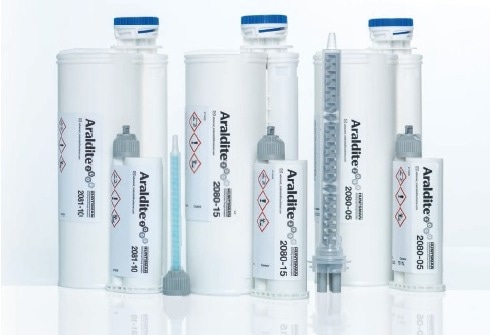Huntsman adhesives are two-component products utilizing reactive chemistry. The ARALDITE® range consists of three primary types of adhesive, each accompanied by its associated hazards, as detailed in this article.

Image Credit: Huntsman Advanced Materials
Precautions Acrylate/Methacrylate Adhesives
- Two-component acrylate and MMA adhesives typically contain acrylate and/ or methacrylate monomers, and a cure initiator found in one of the components. The initiator is often an organic peroxide, either a solid or liquid dispersion.
- Acrylates are irritants and are known to cause sensitivity on the skin and in respiratory function. Using suitable gloves and eye protection is essential, but it is also recommended that adequate ventilation is ensured throughout high exposure.
- The peroxide initiators used in this type of adhesive generally pose a low risk at the concentrations employed, and normal chemical handling precautions are sufficient (gloves and eye protection)
Precautions Two-Component Epoxy Adhesives
- In epoxy adhesives, there is typically a component of epoxy resin and one of a hardener.
- Epoxy resins can induce mild skin and eye irritation upon direct contact, but the primary concern associated with epoxies is sensitization resulting from repeated skin exposure. Sensitization can trigger an allergic reaction, typically manifesting as dermal eczema.
- Hardeners in epoxy adhesives are typically based on amine or thiol chemistry. The primary risk associated with these materials is corrosiveness, which can cause severe skin irritation or even mild burns. Hence, it is crucial to prevent skin and eye contact by utilizing appropriate eye protection and protective gloves.
Precautions Two-Component Polyurethane Adhesives
- Polyurethane adhesives are typically composed of an isocyanate component and a polyol component.
- Isocyanates are recognized as skin and respiratory sensitizers. Apart from using suitable gloves and eye protection, it is important to ensure adequate ventilation when handling these products. Heating the isocyanate component or mixed adhesive (e.g., during oven curing) can pose a specific risk due to the increased release of isocyanate vapors.
- Polyols are typically low-hazard materials; however, they may still cause skin and eye irritation. Therefore, it is advisable to use appropriate protective gloves and eye protection when handling them.

This information has been sourced, reviewed and adapted from materials provided by Huntsman Advanced Materials.
For more information on this source, please visit Huntsman Advanced Materials.